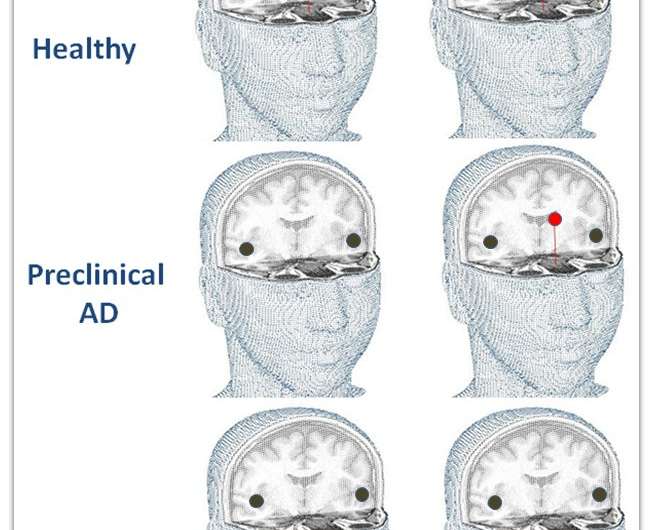'Ideal biomarker' detects Alzheimer's disease before the onset of symptoms

Absence of prefrontal activation during sensory gating of simple tones predicts Alzheimer's disease (AD) before the occurrence of the first symptoms. Sanja Josef Golubic Ph.D., physicist at the Department of Physics, Faculty of Science, University of Zagreb, reports the high potential of this non-invasive biomarker of AD pathology in a new study published in Human Brain Mapping.
Highlights of the new biomarker:
- Absolutely non-invasive
- Detects the condition before the occurrence of the first symptoms (preclinical)
- Discrete: localized/non-localized prefrontal generator
- Does not require estimation of uniform cut-off levels and standardization processes
- Low sensitivity to individual heterogeneity and variability
- Can follow the evolution of the pathophysiological process of AD
- Individual
- Topographic
The worldwide increase of Alzheimer's disease, a long-lasting morbid type of dementia, is currently one of the biggest global public health challenges. A wealth of evidence has emerged over more than 110 years of disease research suggesting that the pathological changes associated with AD start decades before the onset of clinical symptoms. This long progression of neurodegeneration is irreversible by the stage of symptomatic disease, which may account for failure to develop successful disease modifying therapies. Currently, there is a pressing worldwide search for a marker of very early, possibly reversible, pathological changes related to AD in cognitively intact individuals, before the occurrence of the first symptoms.
Reisa Sperling, director of the neuroimaging program at Harvard Medical School, says, "An active line of research is the relationship of intrinsic neural networks and the topographic evolution of the pathophysiological process of AD. It is possible, just as in real estate, that 'location, location, location' is key."
Sanja Josef Golubic found the location—within the topography of the auditory sensory gating network. She uncovered a topological biomarker of preclinical and clinical AD pathology at the individual level that shows a large effect size (0.98) and high accuracy, sensitivity and specificity (100 percent) in identifying symptomatic AD patients within a research sample. The new biomarker does not require estimation of cut-off levels or standardization processes, which is the main problem with previously proposed AD markers. It is absolutely non-invasive, it is not based on the use of group means and is not associated with statistically significant changes in a continuous variable. Its strength lies in the simplicity of a binary value—an activated or non-activated neural generator. The low sensitivity to individual heterogeneity and the variability of its binary nature is probably the most important property of the proposed biomarker.
"Three years ago, we discovered the novel, third fast sensory processing pathway-gating loop, which directly links primary sensory areas to the medial prefrontal cortex within the first 80 milliseconds after auditory stimulation. We provided strong evidence of the modulatory role of the medial prefrontal generator on the dynamics of generators in primary auditory cortices. We also noticed the high sensitivity of the gating generator dynamic on AD pathology. We were inspired to focus our AD biomarker search toward the prefrontal sensory gating generator activation," says Sanja Josef Golubic.
"In the present study, we demonstrate the use of the localization of neural sources underlying neuromagnetic fields measured externally to detect AD even before the onset of symptoms. The healthy controls activated a prefrontal generator in response to both the deviant and repeating tones of an oddball paradigm. To the contrary, the symptomatic AD group was lacking any medial prefrontal gating generator activation to either the deviant or repeating tones. However, we detected a sub-group of controls characterized by the absence of a prefrontal gating generator activation for the repeating tone only, and significantly lower scores on a mini mental status exam and delayed visual memory test—the Rey-Osterreith Complex Figure Test. It is highly probable that these individuals were captured in a preclinical AD phase since they show both neuropsychological and neurophysiological impairments characteristic of an AD type of dementia, although they did not yet meet clinical criteria for the early phase of symptomatic AD," says Josef Golubic.
The next steps in developing the biomarker include testing with large independent samples and assessment in longitudinal clinical studies. The large effect size, absolute non-invasiveness and statistical independence, all properties of an "ideal" biomarker, are promising for clinical use.
More information: Sanja Josef Golubic et al, MEG biomarker of Alzheimer's disease: Absence of a prefrontal generator during auditory sensory gating, Human Brain Mapping (2017). DOI: 10.1002/hbm.23724



















